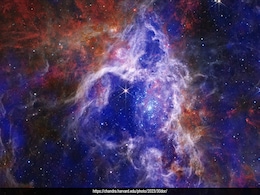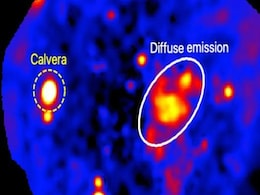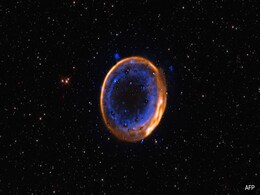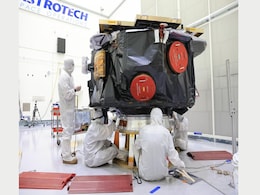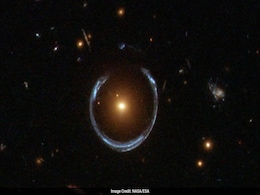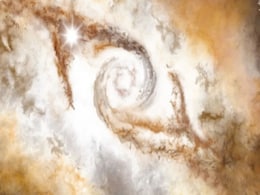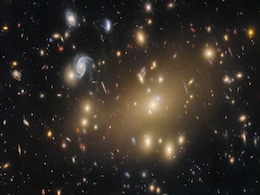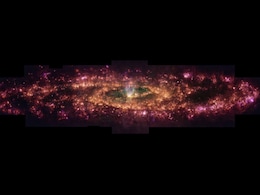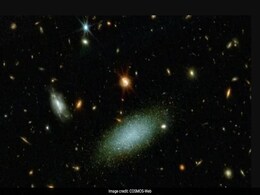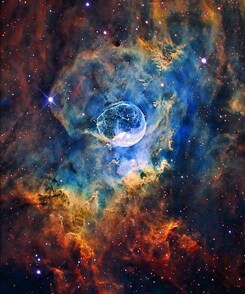Milky Way Galaxy
- All
- News
- Web Stories
-

Indian Scientists Discover Ancient Milky Way-Like Galaxy Alaknanda With Spiral Arms
- Wednesday December 3, 2025
- World News | Edited by NDTV News Desk
Indian scientists have discovered an ancient and massive galaxy called Alaknanda. It looks similar to our Milky Way galaxy and is special because it has clear spiral arms, even though it formed when the universe was only 1.5 billion years old.
-
 www.ndtv.com
www.ndtv.com
-

Dark Matter May Have Been Seen for the First Time in NASA Gamma-Ray Data
- Wednesday November 26, 2025
- Written by Gadgets 360 Staff
A new analysis of NASA’s Fermi telescope data reveals a faint gamma-ray halo around the Milky Way’s core, matching predictions for annihilating dark-matter particles. Researchers say no known astrophysical source fits the signal, raising the possibility of the first direct evidence of dark matter. Experts, however, stress caution and call for v...
-
 www.gadgets360.com
www.gadgets360.com
-

Extreme Star Factory: ALMA Detects Galaxy Y1 Forming Stars 180 Times Faster Than the Milky Way
- Wednesday November 19, 2025
- Written by Gadgets 360 Staff
Using ALMA’s ultra-sensitive Band 9 observations, astronomers identified galaxy Y1 as an extreme star-forming system in the early universe. Producing stars at 180 solar masses per year, Y1 reveals how intense, short-lived starbursts helped shape young galaxies and may have been more common than previously believed.
-
 www.gadgets360.com
www.gadgets360.com
-

For The First Time, Scientists Spot Life's Essentials Frozen In A Distant Galaxy
- Saturday October 25, 2025
- Science | Edited by Nikhil Pandey
Scientists have discovered complex organic molecules, including acetic acid and ethanol, frozen in ice beyond the Milky Way, suggesting that life's chemical ingredients may be widespread across the universe.
-
 www.ndtv.com
www.ndtv.com
-

Flattened Dark Matter May Explain Mysterious Gamma-Ray Glow at Milky Way’s Core, Study Finds
- Sunday October 26, 2025
- Written by Gadgets 360 Staff
Dark matter near the Milky Way’s center appears flattened, not spherical, according to new simulations. The discovery may explain a puzzling gamma-ray glow long observed by NASA’s Fermi telescope, reigniting theories that dark matter collisions produce high-energy radiation in the galaxy’s core
-
 www.gadgets360.com
www.gadgets360.com
-

White Dwarf Gobbles Up Nitrogen-Rich Ices of Pluto-Like World
- Friday September 26, 2025
- World News | Reuters
Astronomers have observed a white dwarf, a highly compact stellar ember, that appears to have gobbled up an icy world akin to dwarf planet Pluto, a finding with implications regarding the likelihood of habitable planets beyond our solar system
-
 www.ndtv.com
www.ndtv.com
-

Astronomers Discover Calvera, a Runaway Pulsar Racing Above the Milky Way
- Wednesday September 3, 2025
- Written by Gadgets 360 Staff
Astronomers have discovered Calvera, a pulsar speeding 6,500 light-years above the Milky Way’s disk. Formed from a supernova in a nearly empty region, Calvera challenges long-held ideas of star birth and death. Its discovery reveals that extreme stellar events can occur even in the galaxy’s sparse outer halo.
-
 www.gadgets360.com
www.gadgets360.com
-

Scientists See Insides Of Dying Star For The First Time
- Wednesday August 20, 2025
- World News | Associated Press
Scientists for the first time have spotted the insides of a dying star as it exploded, offering a rare peek into stellar evolution.
-
 www.ndtv.com
www.ndtv.com
-

Ursa Major III May Be a Star Cluster, Not a Dark-Matter Dwarf Galaxy
- Sunday August 24, 2025
- Written by Gadgets 360 Staff
Astronomers have long thought Ursa Major III, also called UNIONS 1, was a dark-matter-packed dwarf galaxy. But new simulations suggest it may instead be a compact star cluster bound by black holes and neutron stars. Located 30,000 light-years away, Ursa Major III contains just ~60 visible stars yet shows puzzlingly high stellar velocities. The new ...
-
 www.gadgets360.com
www.gadgets360.com
-

Biggest-Ever Black Hole With Mass Of 36 Billion Suns Discovered: 'Cosmic Behemoth'
- Saturday August 9, 2025
- Offbeat | Edited by Abhinav Singh
The gigantic black hole's size is close to the theoretical upper limit of what is possible in the universe.
-
 www.ndtv.com
www.ndtv.com
-

Massive 200-Light-Year Cloud May Be Channeling Matter to the Milky Way's Core
- Saturday August 2, 2025
- Written by Gadgets 360 Staff
Astronomers have discovered a massive, 200-light-year-wide cloud of gas and dust—dubbed the Midpoint cloud—hidden in the Milky Way. This giant molecular cloud appears to channel dense material into the galaxy’s core, possibly fueling star formation. The discovery offers rare insights into how matter flows from the galaxy’s disk to its turbu...
-
 www.gadgets360.com
www.gadgets360.com
-

Hubble Uncovers Multi-Age Stars in Ancient Cluster, Reshaping Galaxy Origins
- Saturday July 19, 2025
- Written by Gadgets 360 Staff
A stunning new image from NASA’s Hubble Space Telescope reveals that ancient star cluster NGC 1786—located 160,000 light-years away in the Large Magellanic Cloud—hosts stars of varying ages. Once believed to contain a single generation of stars, NGC 1786 now appears to preserve a more complex stellar history. This multi-age discovery suggests...
-
 www.gadgets360.com
www.gadgets360.com
-

Pics: Nearby Sculptor Galaxy Revealed In Ultra-Detailed Galactic Image
- Saturday June 21, 2025
- Science | Reuters
Astronomers have released an ultra-detailed image of the Sculptor galaxy obtained with 50 hours of observations using one of the world's biggest telescopes.
-
 www.ndtv.com
www.ndtv.com
-

James Webb Telescope Unveils Largest-Ever Map Of The Universe, Reveals 800,000 Galaxies
- Thursday June 12, 2025
- Science | Edited by Ritu Singh
Spanning 98% of the universe's timeline, this comprehensive dataset was made possible by the James Webb Space Telescope's 255 hours of observation.
-
 www.ndtv.com
www.ndtv.com
-

Milky Way To Collide With Its Largest Neighbour Andromeda? What New Study Said
- Tuesday June 3, 2025
- World News | Edited by NDTV News Desk
Earlier, scientists believed the collision may destroy both galaxies, merging them into an elongated one.
-
 www.ndtv.com
www.ndtv.com
-

Indian Scientists Discover Ancient Milky Way-Like Galaxy Alaknanda With Spiral Arms
- Wednesday December 3, 2025
- World News | Edited by NDTV News Desk
Indian scientists have discovered an ancient and massive galaxy called Alaknanda. It looks similar to our Milky Way galaxy and is special because it has clear spiral arms, even though it formed when the universe was only 1.5 billion years old.
-
 www.ndtv.com
www.ndtv.com
-

Dark Matter May Have Been Seen for the First Time in NASA Gamma-Ray Data
- Wednesday November 26, 2025
- Written by Gadgets 360 Staff
A new analysis of NASA’s Fermi telescope data reveals a faint gamma-ray halo around the Milky Way’s core, matching predictions for annihilating dark-matter particles. Researchers say no known astrophysical source fits the signal, raising the possibility of the first direct evidence of dark matter. Experts, however, stress caution and call for v...
-
 www.gadgets360.com
www.gadgets360.com
-

Extreme Star Factory: ALMA Detects Galaxy Y1 Forming Stars 180 Times Faster Than the Milky Way
- Wednesday November 19, 2025
- Written by Gadgets 360 Staff
Using ALMA’s ultra-sensitive Band 9 observations, astronomers identified galaxy Y1 as an extreme star-forming system in the early universe. Producing stars at 180 solar masses per year, Y1 reveals how intense, short-lived starbursts helped shape young galaxies and may have been more common than previously believed.
-
 www.gadgets360.com
www.gadgets360.com
-

For The First Time, Scientists Spot Life's Essentials Frozen In A Distant Galaxy
- Saturday October 25, 2025
- Science | Edited by Nikhil Pandey
Scientists have discovered complex organic molecules, including acetic acid and ethanol, frozen in ice beyond the Milky Way, suggesting that life's chemical ingredients may be widespread across the universe.
-
 www.ndtv.com
www.ndtv.com
-

Flattened Dark Matter May Explain Mysterious Gamma-Ray Glow at Milky Way’s Core, Study Finds
- Sunday October 26, 2025
- Written by Gadgets 360 Staff
Dark matter near the Milky Way’s center appears flattened, not spherical, according to new simulations. The discovery may explain a puzzling gamma-ray glow long observed by NASA’s Fermi telescope, reigniting theories that dark matter collisions produce high-energy radiation in the galaxy’s core
-
 www.gadgets360.com
www.gadgets360.com
-

White Dwarf Gobbles Up Nitrogen-Rich Ices of Pluto-Like World
- Friday September 26, 2025
- World News | Reuters
Astronomers have observed a white dwarf, a highly compact stellar ember, that appears to have gobbled up an icy world akin to dwarf planet Pluto, a finding with implications regarding the likelihood of habitable planets beyond our solar system
-
 www.ndtv.com
www.ndtv.com
-

Astronomers Discover Calvera, a Runaway Pulsar Racing Above the Milky Way
- Wednesday September 3, 2025
- Written by Gadgets 360 Staff
Astronomers have discovered Calvera, a pulsar speeding 6,500 light-years above the Milky Way’s disk. Formed from a supernova in a nearly empty region, Calvera challenges long-held ideas of star birth and death. Its discovery reveals that extreme stellar events can occur even in the galaxy’s sparse outer halo.
-
 www.gadgets360.com
www.gadgets360.com
-

Scientists See Insides Of Dying Star For The First Time
- Wednesday August 20, 2025
- World News | Associated Press
Scientists for the first time have spotted the insides of a dying star as it exploded, offering a rare peek into stellar evolution.
-
 www.ndtv.com
www.ndtv.com
-

Ursa Major III May Be a Star Cluster, Not a Dark-Matter Dwarf Galaxy
- Sunday August 24, 2025
- Written by Gadgets 360 Staff
Astronomers have long thought Ursa Major III, also called UNIONS 1, was a dark-matter-packed dwarf galaxy. But new simulations suggest it may instead be a compact star cluster bound by black holes and neutron stars. Located 30,000 light-years away, Ursa Major III contains just ~60 visible stars yet shows puzzlingly high stellar velocities. The new ...
-
 www.gadgets360.com
www.gadgets360.com
-

Biggest-Ever Black Hole With Mass Of 36 Billion Suns Discovered: 'Cosmic Behemoth'
- Saturday August 9, 2025
- Offbeat | Edited by Abhinav Singh
The gigantic black hole's size is close to the theoretical upper limit of what is possible in the universe.
-
 www.ndtv.com
www.ndtv.com
-

Massive 200-Light-Year Cloud May Be Channeling Matter to the Milky Way's Core
- Saturday August 2, 2025
- Written by Gadgets 360 Staff
Astronomers have discovered a massive, 200-light-year-wide cloud of gas and dust—dubbed the Midpoint cloud—hidden in the Milky Way. This giant molecular cloud appears to channel dense material into the galaxy’s core, possibly fueling star formation. The discovery offers rare insights into how matter flows from the galaxy’s disk to its turbu...
-
 www.gadgets360.com
www.gadgets360.com
-

Hubble Uncovers Multi-Age Stars in Ancient Cluster, Reshaping Galaxy Origins
- Saturday July 19, 2025
- Written by Gadgets 360 Staff
A stunning new image from NASA’s Hubble Space Telescope reveals that ancient star cluster NGC 1786—located 160,000 light-years away in the Large Magellanic Cloud—hosts stars of varying ages. Once believed to contain a single generation of stars, NGC 1786 now appears to preserve a more complex stellar history. This multi-age discovery suggests...
-
 www.gadgets360.com
www.gadgets360.com
-

Pics: Nearby Sculptor Galaxy Revealed In Ultra-Detailed Galactic Image
- Saturday June 21, 2025
- Science | Reuters
Astronomers have released an ultra-detailed image of the Sculptor galaxy obtained with 50 hours of observations using one of the world's biggest telescopes.
-
 www.ndtv.com
www.ndtv.com
-

James Webb Telescope Unveils Largest-Ever Map Of The Universe, Reveals 800,000 Galaxies
- Thursday June 12, 2025
- Science | Edited by Ritu Singh
Spanning 98% of the universe's timeline, this comprehensive dataset was made possible by the James Webb Space Telescope's 255 hours of observation.
-
 www.ndtv.com
www.ndtv.com
-

Milky Way To Collide With Its Largest Neighbour Andromeda? What New Study Said
- Tuesday June 3, 2025
- World News | Edited by NDTV News Desk
Earlier, scientists believed the collision may destroy both galaxies, merging them into an elongated one.
-
 www.ndtv.com
www.ndtv.com




